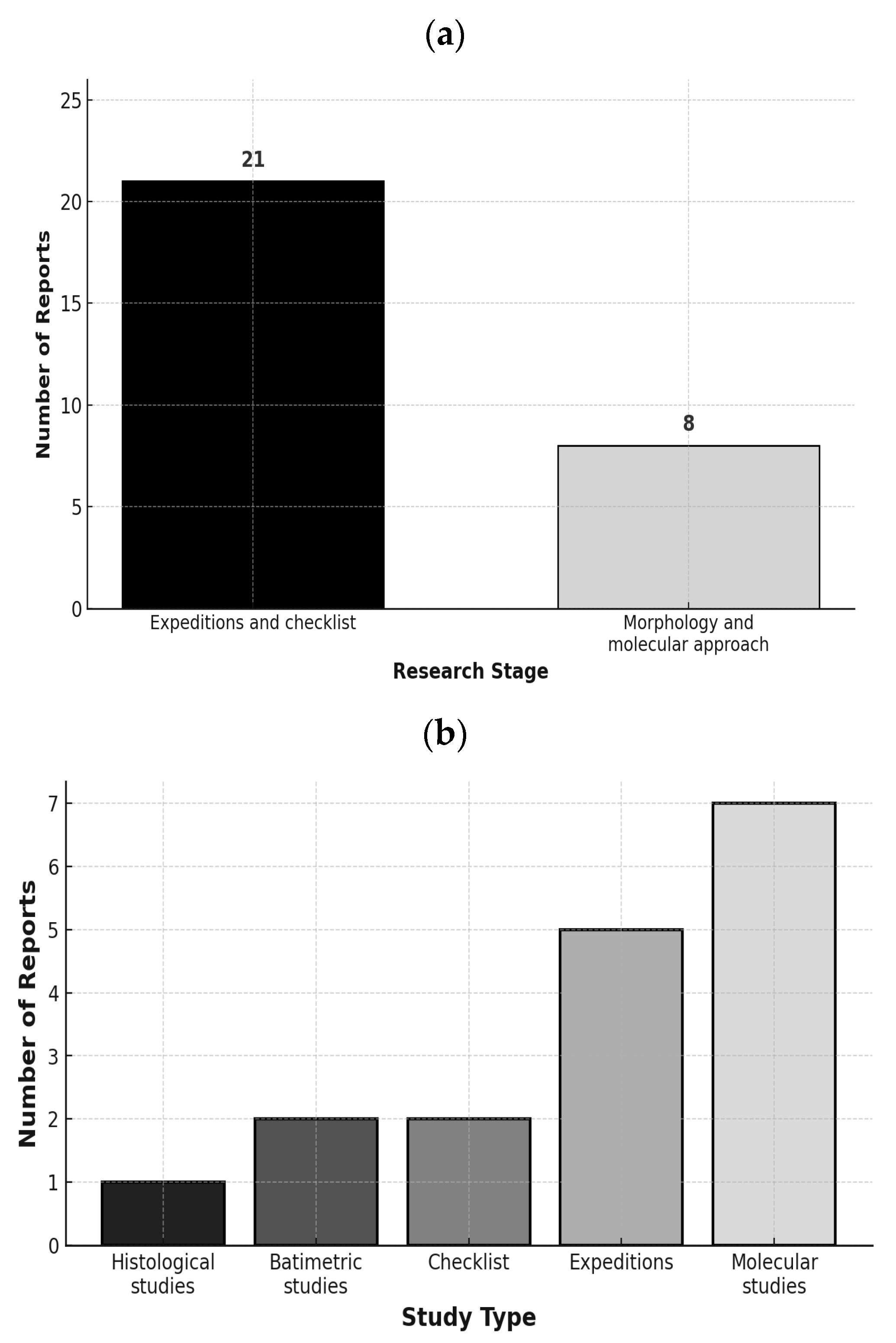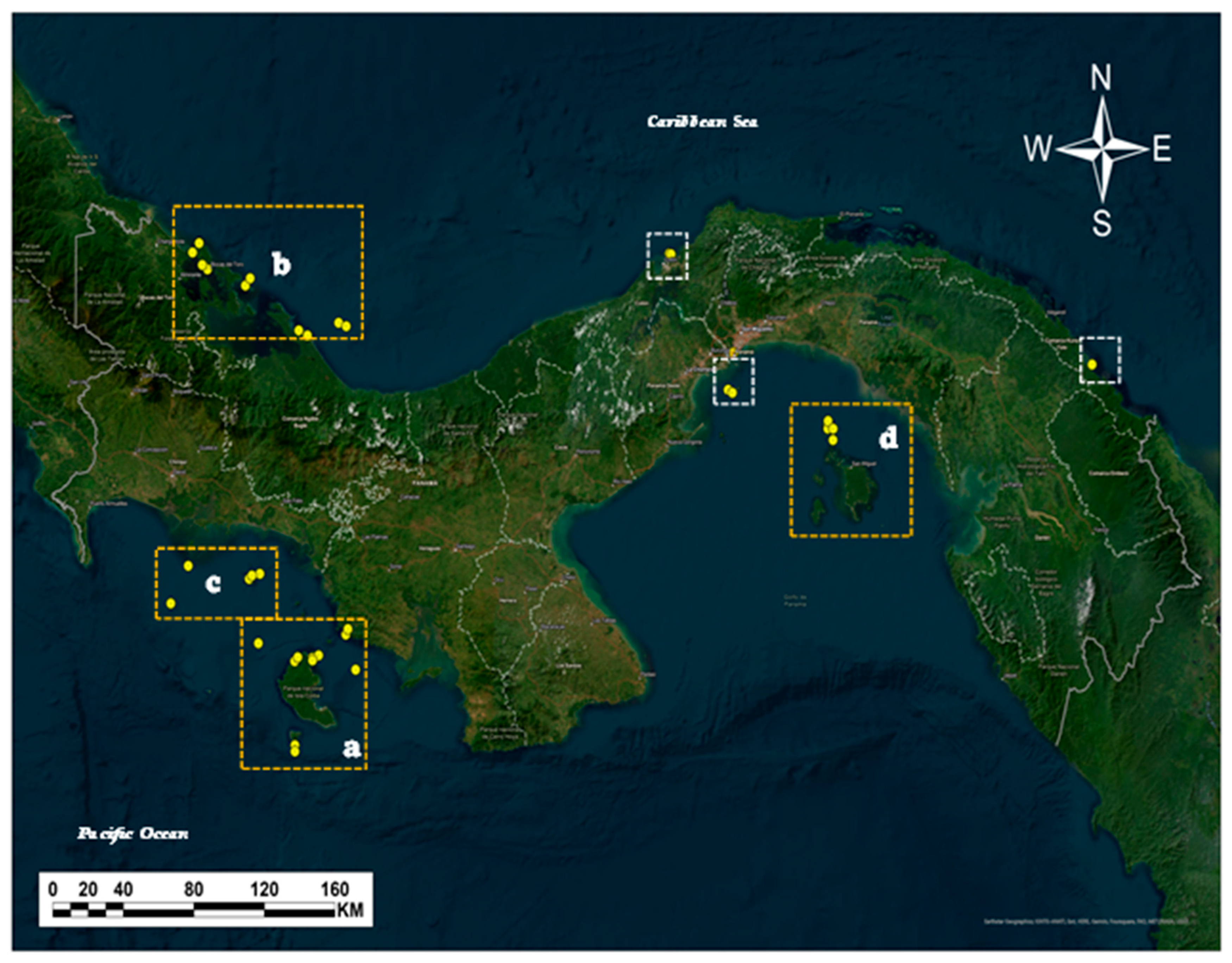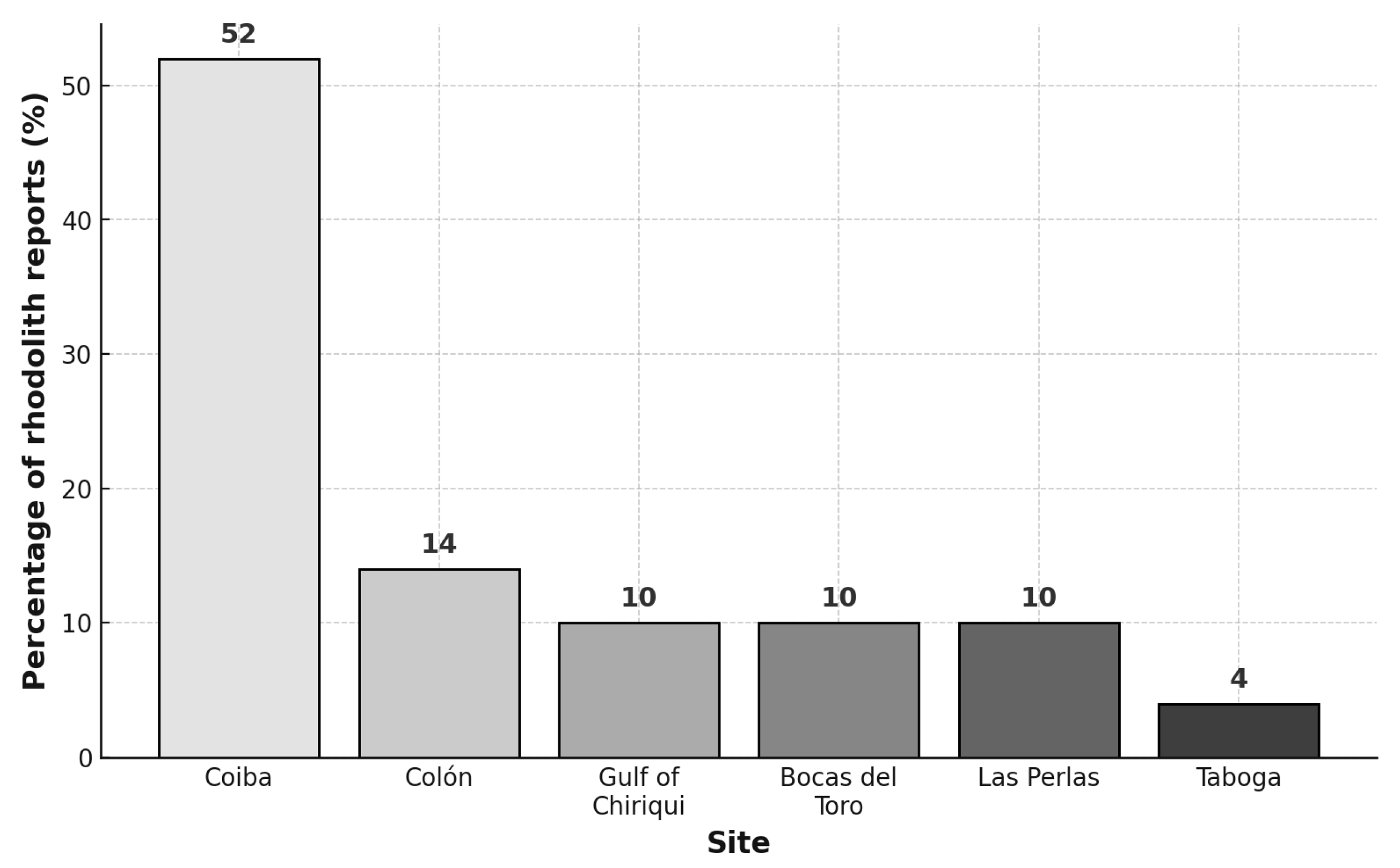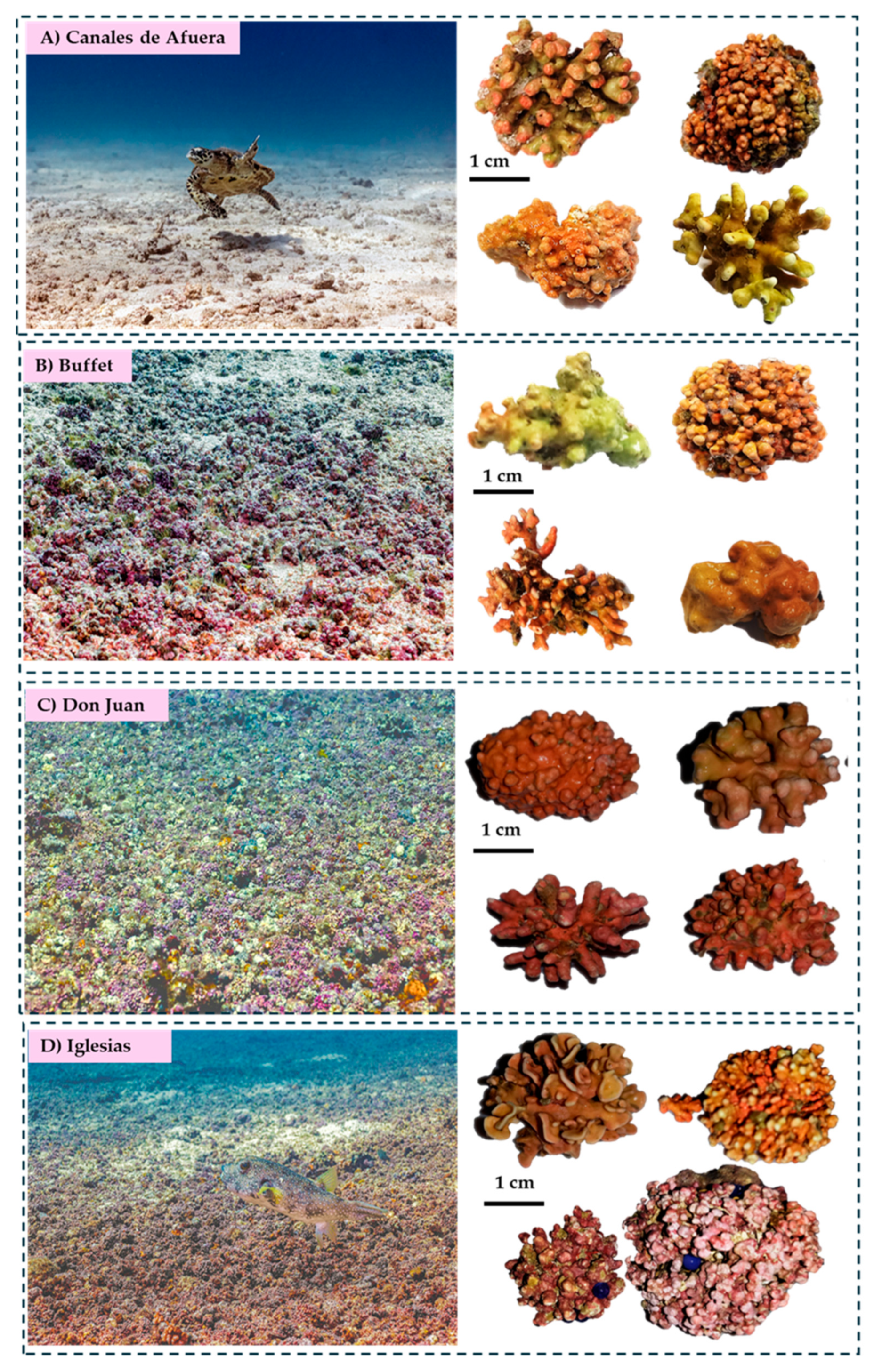Rhodolith Diversity in Panama: A Baseline for Future Research and Conservation Actions
Abstract
1. Introduction
2. Materials and Methods
2.1. Literature Review
2.2. General Settings of Rodolith Beds at Coiba National Park
3. Results and Discussion
3.1. Historical Review
3.2. Checklist of Rhodolith Species in Panama
3.3. Reports to Be Confirmed
3.4. Misreportings
3.5. Localization and Diversity
3.6. Molecular Studies Data
3.7. Rhodolith Beds at Coiba National Park (PNC)
3.8. Ecological Role, Threats, and Conservation
- Integration into management plans: Incorporate rhodoliths as objectives of conservation into the management plans of marine protected areas where their presence is known, as well as other marine areas.
- Research and Monitoring: Promote research to understand the diversity of rhodoliths and explore the ecology, distribution, and genetics of rhodolith beds in Panama. Establish long-term monitoring programs to assess the condition of these algae and their response to threats, as well as evaluate the conservation status of their populations.
- Education: Raise awareness about the ecological importance of rhodoliths among decision makers, local communities, and the public.
- Collaboration and funding: Encourage collaboration between researchers, conservation organizations, and government agencies to address the conservation challenges of rhodolith beds. Seek funding to support research, monitoring, and conservation initiatives.
- Regulation and fisheries management: Implement fisheries regulations to protect rhodolith beds from trawling in marine areas that are not protected. In protected areas, strengthen and enforce regulations to maintain ecosystem sustainability.
4. Conclusions
Supplementary Materials
Author Contributions
Funding
Institutional Review Board Statement
Data Availability Statement
Acknowledgments
Conflicts of Interest
Abbreviations
| PNC | Coiba National Park. |
| CMAR | Eastern Tropical Pacific Marine Corridor. |
| EBSAs | Ecologically or Biologically significant Marine Areas. |
| SNFs | Small Natural Features. |
| NE | North East. |
| NIH | National Institutes of Health |
Appendix A
| # | Specie | Locality | ID | GenBank Accesion | |||||
|---|---|---|---|---|---|---|---|---|---|
| COX2 | LSU | COI | rbcL | UPA | psbA | ||||
| 1 | Harveylithon sp. | Wild Cay, BT | PHYKOS 7053 | ---- | ---- | ---- | ---- | ---- | MW452886 |
| 2 | H. munitum | Escudo de Veraguas, BT | PHYKOS_3593 | ---- | MW457636.1 | ---- | MF979962 | ---- | ---- |
| 3 | Lithophyllum sp. | Cebaco Island, VE | LAF7219 | ---- | KJ412333.1 | KJ418417.1 | ---- | ---- | KJ418411.1 |
| 4 | Lithophyllum sp. 3 | Swan Cay, BT | FBCS12912 | KJ801356.1 | ---- | ---- | ---- | ---- | ---- |
| 5 | Lithophyllum sp. 3 | Sand Fly Bay, BT | FBCS12913 | KJ801357.1 | ---- | ---- | ---- | ---- | ---- |
| 6 | Lithothamnion sp. 4 | Swan Cay, BT | FBCS12920 | KJ801364.1 | ---- | ---- | ---- | ---- | ---- |
| 7 | Lithothamnion sp. D | Gulf of Chiriqui | LAF6631 | ---- | ---- | ---- | ---- | KU519740 | KU557500 |
| 8 | Lithothmanion 1 | Swan Cay, BT | FBCS12917 | KJ801365.1 | ---- | ---- | ---- | ---- | ---- |
| 9 | Lithothamnion sp. J | Tintorera Island, VE | PHYKOS7249 | ---- | KR075891.1 | KU504277 | ---- | KU504275 | KP844865 |
| 10 | Lithophyllum neocongestum | Bocas del Toro | NCU 598862 | ---- | ---- | ---- | KX020485 | ---- | ---- |
| 11 | Lithophyllum neocongestum | Bocas del Toro | US223011 | ---- | ---- | ---- | KX020484.1 | ---- | KX020466 |
| 12 | Lithophyllum neocongestum | Bocas del Toro | US169412 | ---- | ---- | ---- | ---- | ---- | KX020486 |
| 13 | Lithophyllum neocongestum | Flat Rock Beach, BT | US170968 | ---- | ---- | ---- | ---- | ---- | KX020440 |
| 14 | Lithophyllum neocongestum | Sand Fly Bay, BT | US170967 | ---- | ---- | ---- | ---- | ---- | KX020441 |
| 15 | Neogoniolithon sp. | Panama | VPF00177 | ---- | ---- | KM392370.1 | ---- | ---- | ---- |
| 16 | Sporolithon episporum | Punta Toro, Colón | NY_900041 | ---- | ---- | ---- | KY994125.1 | ---- | ---- |
| 17 | Sporolithon episporum | Bocas del Toro | NCU_598843 | ---- | ---- | KY994113.1 | KY994124.1 | ---- | MF034547.1 |
| 18 | Sporolithon sp. | Mono Feliz, GC | PHYKOS_4623 | ---- | ---- | ---- | ---- | ---- | MF034548.1 |
References
- Riosmena-Rodríguez, R. Chapter 1: Natural History of Rhodolith/Maërl Beds: Their Role in Near-Shore Biodiversity and Management. In Rhodolith/Maërl Beds: A Global Perspective, 1st ed.; Riosmena-Rodríguez, R., Nelson, W., Aguirre, J., Eds.; Springer: Cham, Switzerland, 2017; pp. 3–26. [Google Scholar]
- Tuya, F.; Schubert, N.; Aguirre, J.; Basso, D.; Bastos, E.; Berchez, F.; Bernardino, A.; Bosch, N.; Burdett, H.; Espino, F.; et al. Levelling-up rhodolith-bed science to address global-scale conservation challenges. Sci. Total Environ. 2023, 892, 164818. [Google Scholar] [CrossRef]
- Fredericq, S.; Krayesky, S.; Sauvage, T.; Richards, J.; Kittle, R.; Arakaki, N.; Schmidt, W. The Critical Importance of Rhodoliths in the Life Cycle Completion of Both Macro- and Microalgae, and as Holobionts for the Establishment and Maintenance of Marine Biodiversity. Front. Mar. Sci. 2018, 5, 505. [Google Scholar] [CrossRef]
- Martin, S.; Hall-Spencer, J. Chapter 3: Effects of Ocean Warming and Acidification on Rhodolith/Maërl Beds. In Rhodolith/Maërl Beds: A Global Perspective, 1st ed.; Riosmena-Rodríguez, R., Nelson, W., Aguirre, J., Eds.; Springer: Cham, Switzerland, 2017; pp. 55–85. [Google Scholar]
- Ragazzola, F.; Foster, L.C.; Form, A.; Anderson, P.S.; Hansteen, T.H.; Fietzke, J. Ocean acidification weakens the structural integrity of coralline algae. Glob. Change Biol. 2012, 18, 2804–2812. [Google Scholar] [CrossRef] [PubMed]
- Andersson, A.J.; Bates, N.R.; Mackenzie, F.T. Dissolution of carbonate sediments under rising pCO2 and ocean acidification: Observations from Devil’s Hola, Bermuda. Aquat. Geochem. 2007, 13, 237–264. [Google Scholar] [CrossRef]
- Morse, J.; Andersson, A.; Mackenzie, F. Initial responses of carbonate-rich shelf sediments to rising atmospheric pCO2 and “ocean acidification”: Role of high Mg-calcites. Geochim. Cosmochim. Acta 2006, 70, 5814–5830. [Google Scholar] [CrossRef]
- Diaz-Licona, C.; Schubert, N.; González-Gamboa, V.; Tuya, F.; Azofeifa-Solano, J.; Fernández-García, C. Rhodolith beds in the Eastern Tropical Pacific: Habitat structure and associated biodiversity. Aquat. Bot. 2025, 201, 103914. [Google Scholar] [CrossRef]
- Ministerio de Ambiente. Plan de Manejo del Parque Nacional Coiba 2024. Panamá. Available online: https://miambiente.gob.pa/download/plan-de-manejo-del-parque-nacional-coiba-borrador-final-may24/ (accessed on 3 October 2024).
- Howe, M. Report on a botanical visit to the Isthmus of Panama. J. New York Bot. Gard. 1910, 11, 30–44. [Google Scholar]
- Howe, M. On some fossil and recent Lithothamnieae of the Panama Canal Zone. US. Natl. Mus. Bull. 1918, 103, 1–13. [Google Scholar]
- Lemoine, M.P. Les Corallinacees de l’ Archipel des Galapagos et du Golfe de Panama. Arch. Mus. Hist. Nat. 1929, 6, 47–88. [Google Scholar]
- Taylor, W.R. Pacific marine algae of the Allan Hancock expeditions to the Galapagos Islands. Allan Hancock Pac. Exp. 1945, 12, 1–528. [Google Scholar]
- Dawson, E.Y. New records of marine algae from Pacific Mexico and Central America. Pac. Nat. 1960, 1, 31–52. [Google Scholar]
- Earle, S. A review of the marine plants of Panama. Bull. Biol. Soc. Wash. 1972, 2, 69–87. [Google Scholar]
- Guzmán, H.; Guevara, C.; Breddy, O. Distribution, diversity, and conservation of coral reefs and coral communities in the largest marine protected area of Pacific Panama (Coiba Island). Environ. Conserv. 2004, 31, 111–121. [Google Scholar] [CrossRef]
- Littler, M.; Litller, D. Coralline algal rhodoliths form extensive benthic communities in the Gulf of Chiriqui, Pacific Panama. Coral Reefs 2008, 27, 553. [Google Scholar] [CrossRef]
- Martínez, J. Extensiones de Rango y Nuevas Especies de Algas Coralinas (Corallinales, Rodophyta) Formadoras de Mantos de Rodolitos en el. CaribeBachelor Thesis, Universidad Autónoma de Baja California Sur, La Paz, Mexico, 2013. [Google Scholar]
- Richards, J.; Vieira-Pinto, T.; Schmidt, W.; Sauvage, T.; Gabrielson, P.; Oliveira, M.; Fredericq, S. Molecular and Morphological Diversity of Lithothamnion spp. (Hapalidiales, Rhodophyta) from Deepwater Rhodolith Beds in the Northwestern Gulf of Mexico. Phytotaxa 2016, 278, 81–114. [Google Scholar] [CrossRef]
- Richards, J.; Sauvage, T.; Schmidt, W.; Fredericq, S.; Hughey, J.; Gabrielson, P. The coralline genera Sporolithon and Heydrichia (Sporolithales, Rhodophyta) clarified by sequencing type material of their generitypes and other species. J. Phycol. 2017, 53, 1044–1059. [Google Scholar] [CrossRef]
- Richards, J.; Schmidt, W.; Fredericq, S.; Sauvage, T.; Peña, V.; Gall, L.; Mateo-Cid, L.E.; Mendoza-González, A.C.; Hughey, J.; Gabrielson, P. DNA sequencing of type material and newly collected specimens reveals two heterotypic synonyms for Harveylithon munitum (Metagoniolithoideae, Corallinales, Rhodophyta) and three new species. J. Phycol. 2021, 57, 1234–1253. [Google Scholar] [CrossRef] [PubMed]
- Richards, J.; Kittle, R.; Schmidt, W.; Sauvage, T.; Gurgel, C.; Gabriel, D.; Fredericq, S. Assessment of Rhodolith Diversity in the Northwestern Gulf of Mexico Including the Description of Sporolithon gracile sp. nov. (Sporolithales, Rhodophyta), and Three New Species of Roseolithon (Hapalidiales, Rhodophyta). Front. Mar. Sci. 2022, 9, 906679. [Google Scholar] [CrossRef]
- Dawson, E.Y. A guide to the literature and distributions of Pacific benthic algae from Alaska to the Galapagos Islands. Pac. Sci. 1961, 15, 370–461. [Google Scholar]
- Fernández-García, C.; Riosmena-Rodríguez, R.; Wysor, B.; Tejeda, O.L.; Cortés, J. Checklist of the Pacific marine macroalgae of Central America. Bot. Mar. 2011, 54, 53–57. [Google Scholar] [CrossRef]
- Taylor, W.R. Caribbean Marine Algae of the Allan Hancock Expedition. Allan Hancock Atl. Exped. 1939, 2, 193. [Google Scholar]
- Hernandez-Kantun, J.; Gabrielson, P.; Hughey, J.; Pezzolesi, L.; Rindi, F.; Robinson, N.; Peña, V.; Riosmena-Rodriguez, R.; Gall, L.; Adey, W. Reassessment of branched Lithophyllum spp. (Corallinales, Rhodophyta) in the Caribbean Sea with global implications. Phycologia 2016, 55, 619–639. [Google Scholar] [CrossRef]
- Taylor, W.R. Marine Algae of the Eastern Tropical and Subtropical Coasts of the Americas; The University of Michigan Press: Ann Arbor, MI, USA, 1960; p. 870. [Google Scholar]
- Taylor, W.R. Notes on algae from the tropical Atlantic Ocean. Amer. J. Bot. 1929, 16, 621–630. [Google Scholar] [CrossRef]
- Gabrielson, P.; Hughey, R.; Diaz-Pulido, G. Genomics reveals abundant speciation in the coral reef building alga Porolithon onkodes (Corallinales, Rhodophyta). J. Phycol. 2018, 54, 429–434. [Google Scholar] [CrossRef]
- Gómez, D.; Pérez, H. Estimación de la Riqueza y Abundancia de Macroalgas en los Arrecifes de Punta Galeta, 15 Años Después de un Derrame de Petróleo. Bachelor’s Thesis, Universidad de Panamá, Panama, 2004. [Google Scholar]
- Robinson, N. Sistemática de las Especies de Algas Coralinas (Corallinophycidae, Rhodophyta) Formadoras de Mantos De Rodolitos en el Pacífio Tropical Oriental. Master’s Thesis, Universidad Autónoma de Baja California Sur, La Paz, Mexico, 2013. [Google Scholar]
- Dawson, E.Y. Marine algae from the 1958 Cruise of the Stella Polaris in the Gulf of California. Contrib. Sci. 1959, 27, 1–39. [Google Scholar] [CrossRef]
- León, N.; Pérez, C.; Fernández García, C.; Díaz Ferguson, E. Caracterización morfoestructural y molecular de rodolitos (Corallinales) del Parque Nacional Coiba. In Proceedings of the XII Latin American and Caribbean Phycology Congress, Costa Rica, 18–22 November 2024. [Google Scholar]
- Robinson, N.; Fernández-García, C.; Riosmena-Rodríguez, R.; Rosas-Alquicira, E.; Konar, B.; Chenelot, H.; Jewett, S.; Melzer, R.; Meyer, R.; Försterra, G.; et al. Chapter 13: Eastern Pacific. In Rhodolith/Maërl Beds: A Global Perspective, 1st ed.; Riosmena-Rodríguez, R., Nelson, W., Aguirre, J., Eds.; Springer: Cham, Switzerland, 2017; pp. 319–333. [Google Scholar]
- Wysor, B.; Kooistra, W. An annotated list of marine Chlorophyta from the Caribbean coast of the Republic of Panama. Nova Hedwig. Beih. 2003, 77, 487–523. [Google Scholar] [CrossRef]
- Wysor, B. An annotated list of marine Chlorophyta from the Pacific Coast of the Republic of Panama with a comparison to Caribbean Panama species. Nova Hedwig. Beih. 2004, 78, 209–241. [Google Scholar] [CrossRef]
- Hunter, M.; Acuña, V.; Bauer, D.; Bell, K.; Calhoun, A.; Felipe-Lucia, M.; Fitzsimons, J.; González, E.; Kinnison, M.; Lindenmayer, D.; et al. Conserving small natural features with large ecological roles: A synthetic overview. Biol. Conserv. 2017, 211 Pt B, 88–95. [Google Scholar] [CrossRef]
- Amado-Filho, G.; Bahia, R.; Guilherme, H.; Pereira-Filho, G.; Longo, L. Chapter 12: South Atlantic Rhodolith Beds: Latitudinal Distribution, Species Composition, Structure and Ecosystem Functions, Threats and Conservation Status. In Rhodolith/Maërl Beds: A Global Perspective, 1st ed.; Riosmena-Rodríguez, R., Nelson, W., Aguirre, J., Eds.; Springer: Cham, Switzerland, 2017; pp. 299–314. [Google Scholar]
- Díaz Licona, C. Mantos de Rodolitos (Rhodophyta) del Pacífico Costarricense: Caracterización e Identificación de Posibles Servicios Ecosistémicos Para Generar Recomendaciones de Manejo. Master’s Thesis, Universidad de Costa Rica, San José, Costa Rica, 2024. [Google Scholar]
- Amado-Filho, G.M.; Maneveldt, G.W.; Pereira-Filho, G.H.; Manso, R.C.; Bahia, R.G.; Barros-Barreto, M.B.; Guimarães, S.M. Seaweed diversity associated with a Brazilian tropical rhodolith bed. Cien. Mar. 2010, 36, 371–391. [Google Scholar] [CrossRef]
- Solano-Barquero, A.; Sibaja-Cordero, J.; Cortés, J. Macrofauna associated with a rhodolith bed at an oceanic island in the Eastern Tropical Pacific (Isla del Coco National Park, Costa Rica). Front. Mar. Sci. 2022, 9, 858416. [Google Scholar] [CrossRef]
- León, N.; Valdespino, I.; Garibaldi, C.; Fernández García, C.; Díaz Ferguson, E. Documentando a los rodolitos: Bioingenieros del Parque Nacional Coiba. In Proceedings of the XIX National Congress of Science and Technology, APANAC, Panama City, Panama, 26–29 September 2023. [Google Scholar]
- Bassi, D.; Simone, L.; Nebelsick, J. Chapter 6: Resedimented Rhodoliths in Channelized Depositional Systems. In Rhodolith/Maërl Beds: A Global Perspective, 1st ed.; Riosmena-Rodríguez, R., Nelson, W., Aguirre, J., Eds.; Springer: Cham, Switzerland, 2017; pp. 139–168. [Google Scholar]
- Acuña, F.; Cortés, J.; Garese, A.; González-Muñoz, R. The sea anemone Exaiptasia diaphana (Actiniaria: Aiptasiidae) associated to rhodoliths at Isla del Coco National Park, Costa Rica. Rev. Biol. Trop. 2020, 68, S283–S288. [Google Scholar] [CrossRef]
- Hall-Spencer, J. Conservation issues relating to maerl beds as habitats for molluscs. J. Conchol. 1998, 2, 271–286. [Google Scholar]
- Simon-Nutbrown, C.; Hollingsworth, P.; Fernandes, T.; Kamphausen, L.; Baxter, J.; Burdett, H. Species Distribution Modeling Predicts Significant Declines in Coralline Algae Populations Under Projected Climate Change with Implications for Conservation Policy. Front. Mar. Sci. 2020, 7, 575825. [Google Scholar] [CrossRef]
- Kamenos, N.; Burdett, H.; Darrenougue, N. Chapter 2: Coralline Algae as Recorders of Past Climatic and Environmental Conditions. In Rhodolith/Maërl Beds: A Global Perspective, 1st ed.; Riosmena-Rodríguez, R., Nelson, W., Aguirre, J., Eds.; Springer: Cham, Switzerland, 2017; pp. 27–53. [Google Scholar]
- Birkett, D.; Maggs, C.; Dring, M.; Boaden, P. An overview of dynamic and sensitivity characteristics for conservation management of marine SACs. Scott. Assoc. Mar. Sci. 1998, 5. [Google Scholar]
- Hall-Spencer, J.; Grall, J.; Moore, P.; Atkinson, R. Bivalve fishing and maerl-bed conservation in France and the UK-retrospect and prospect. Aquat. Conserv. 2003, 13, S33–S41. [Google Scholar] [CrossRef]
- Adey, W.; Halfar, J.; Williams, B. The coralline genus Clathromorphum foslie emend. Adey; biological, physiological and ecological factors controlling carbonate production in an Arctic/Subarctic climate archive. Smithson. Contr. Mar. Sc. 2013, 40, 1–83. [Google Scholar] [CrossRef]
- Rebelo, A.; Teichert, S.; Bracchi, V.; Rasser, M.; Basso, D. Crustose coralline red algae frameworks and rhodoliths: Past and present. Front. Earth Sci. 2022, 10, 1090091. [Google Scholar] [CrossRef]
- Antunez Horta, P.; Riul, P.; Amado Filho, G.; Gurgel, C.; Berchez, F.; de Castro, J.; Figueiredo, M. Rhodoliths in Brazil: Current knowledge and potential impacts of climate change. Braz. J. Oceanogr. 2016, 64, 117–136. [Google Scholar] [CrossRef]
- Alvarado, J.J.; Herrera, B.; Corrales, L.; Asch, J.; Paaby, P. Identificación de las prioridades de conservación de la biodiversidad marina y costera en Costa Rica. Rev. Biol. Trop. 2011, 59, 829–842. [Google Scholar] [CrossRef] [PubMed][Green Version]







| Family/Subfamily/Species | Locality |
|---|---|
| Corallinaceae Subfamily Chamberlainoideae | |
| Chamberlainium decipiens (Foslie) Caragnano, Foetisch, Maneveldt & Payri (as Spongites decipiens) [23,24] | Pacific |
| Pneophyllum confervicola (Kützing) Y.M. Chamberlain: (as Heteroderma minutulum) [23,24] | Pacific |
| Subfamily Lithophylloideae | |
| Lithophyllum coibense Me. Lemoine [12,24] | Pacific |
| Lithophyllum brachiatum (Heydrich) Me. Lemoine [12,24,25] | Pacific |
| Lithophyllum alternans Me. Lemoine [17,24] | Pacific |
| Lithophyllum okamurae Foslie [20] | Pacific |
| Lithophyllum prototypum (Foslie) Foslie (as Goniolithon tessellatum) [15,23,24] | Pacific |
| Lithophyllum pallescens (Foslie) Foslie [23,24] | Pacific |
| Lithophyllum divaricatum Me. Lemoine [13,24] | Pacific |
| Lithophyllum neocongestum J.J. Hernandez-Kantun, W.H. Adey & P.W. Gabrielson [26] | Caribbean |
| Titanoderma pustulatum (J.V. Lamouroux) Nägeli [15,27,28] | Caribbean |
| Subfamily Mastophoroideae | |
| Goniolithon decutescens (Heydrich) Foslie ex M. Howe [20,25] | Caribbean |
| Subfamily Metagoniolithoideae | |
| Harveylithon munitum (Foslie & M. Howe) A. Rösler, Perfectti, V. Peña & J.C. Braga [21,29] | Caribbean |
| Subfamily Neogoniolithoideae | |
| Neogoniolithon trichotomum (Heydrich) Setchell & L.R. Mason [23,24] | Pacific |
| Hapalidiaceae | |
| Subfamily Melobesioideae | |
| Lithothamnion australe Foslie [23,24] | Pacific |
| Lithothamnion australe f. americanum Foslie [13,24] | Pacific |
| Lithothamnion crispatum Hauck (as L. indicum) [12,17,24] | Pacific |
| Lithothamnion australe f. minutulum Foslie (as Mesophyllum australe var. minutula) [12] | Pacific |
| Mesophyllum australe var. tualense (Foslie) Me. Lemoine [12,24] | Pacific |
| Sporolithaceae | |
| Sporolithon episporum (M.Howe) E.Y. Dawson [12,15,17,27] | Caribbean |
| Sporolithon howei (Lemoine) N.Y. Yamaguishi-Tomita ex M.J. Wynne: (as Archaeolithothamnion howei) [12,14,24] | Pacific |
| Locality/Species |
|---|
| CARIBBEAN Ϯ Clathromorphum Foslie |
| Hydrolithon farinosum (J.V. Lamouroux) Penrose & Y.M. Chamberlain (as Fosliella farinosa) [15,25,27] |
| Lithophyllum corallinae (P. Crouan & H. Crouan) Heydrich [18] |
| Ϯ Lithophyllum kaiseri (Heydrich) Heydrich |
| Lithophyllum stictaeforme (Areschoug) Hauck [19] |
| Ϯ Mesophyllum mesomorphum (Foslie) W.H. Adey |
| Neogoniolithon spectabile (Foslie) Setchell & L.R. Mason [30] |
| Ϯ Neogoniolithon strictum (Foslie) Setchell & L.R. Mason |
| Porolithon sp. Foslie [15] |
| PACIFIC |
| Fosliella fertilis (Me. Lemoine) Segonzac [17,24] |
| Fosliella minuta W.R. Taylor [13,15,24] |
| Ϯ Hydrolithon boergesenii (Foslie) Foslie |
| Ϯ Hydrolithon breviclavium (Foslie) Foslie |
| Ϯ Hydrolithon boergesenii (Foslie) Foslie |
| Ϯ Lithophyllum imitans Foslie |
| Ϯ Lithophyllum kotschyanum Foslie |
| Ϯ Phymatolithon lenormandii (Areschoug) W.H. Adey |
| Ϯ Mesophyllum engelhartii (Foslie) W.H. Adey |
| Phymatolithon masonianum Wilks & Woelkerling [31] |
| Ϯ Porolithon onkodes (Heydrich) Foslie [24,32] |
| Ϯ Porolithon sonorense E.Y. Dawson |
| Ϯ Spongites fruticulosus Kützing [33] |
| SITE | Latitude° N | Longitude° W | Coverage (%) | Depth (ft) |
|---|---|---|---|---|
| Canales de Afuera | 7.68888 | −81.63419 | 46 | 45 |
| Buffet | 7.68537 | −81.61061 | 49 | 55 |
| Don Juan | 7.39809 | −81.63869 | 65 | 42 |
| Iglesias | 7.64542 | −81.69166 | 69 | 32 |
Disclaimer/Publisher’s Note: The statements, opinions and data contained in all publications are solely those of the individual author(s) and contributor(s) and not of MDPI and/or the editor(s). MDPI and/or the editor(s) disclaim responsibility for any injury to people or property resulting from any ideas, methods, instructions or products referred to in the content. |
© 2025 by the authors. Licensee MDPI, Basel, Switzerland. This article is an open access article distributed under the terms and conditions of the Creative Commons Attribution (CC BY) license (https://creativecommons.org/licenses/by/4.0/).
Share and Cite
León, N.; Fernández-García, C.; Wysor, B.; Valdespino, I.A.; Díaz-Ferguson, E. Rhodolith Diversity in Panama: A Baseline for Future Research and Conservation Actions. Diversity 2025, 17, 700. https://doi.org/10.3390/d17100700
León N, Fernández-García C, Wysor B, Valdespino IA, Díaz-Ferguson E. Rhodolith Diversity in Panama: A Baseline for Future Research and Conservation Actions. Diversity. 2025; 17(10):700. https://doi.org/10.3390/d17100700
Chicago/Turabian StyleLeón, Noemí, Cindy Fernández-García, Brian Wysor, Iván A. Valdespino, and Edgardo Díaz-Ferguson. 2025. "Rhodolith Diversity in Panama: A Baseline for Future Research and Conservation Actions" Diversity 17, no. 10: 700. https://doi.org/10.3390/d17100700
APA StyleLeón, N., Fernández-García, C., Wysor, B., Valdespino, I. A., & Díaz-Ferguson, E. (2025). Rhodolith Diversity in Panama: A Baseline for Future Research and Conservation Actions. Diversity, 17(10), 700. https://doi.org/10.3390/d17100700









